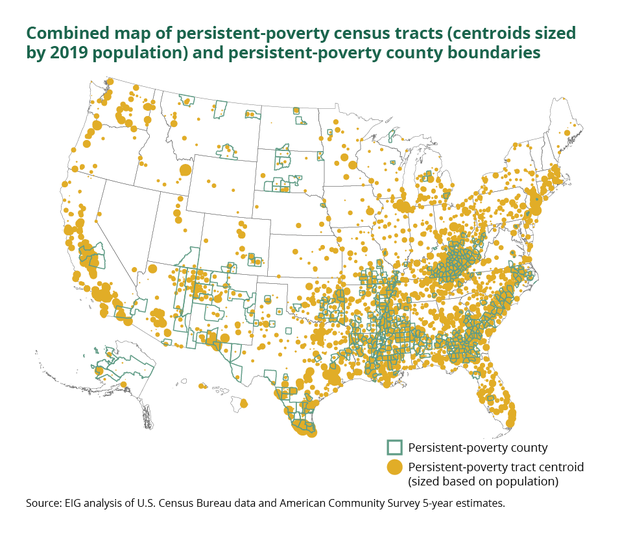"Persistent poverty" exists across much of the U.S.: "The ultimate left-behind places"
Although the U.S. has periodically sought to reduce poverty around the country since the 1960s, roughly 35 million Americans — or almost 1 in 10 — live in communities suffering from "persistent poverty," a recent analysis shows.
That troubling number is 72% higher than previously thought, according to the Economic Innovation Group, which focused on areas where the poverty rate has remained above 20% for more than three decades. To arrive at their figures, the public policy group examined poverty by Census tract — smaller geographic divisions of a county — rather than at the current county level, which can mask pockets of impoverishment.
For instance, by some measures there are no counties in Maine, New Hampshire or Vermont that rank as persistently poor. But each of these states encompasses smaller Census tracts that meet the definition, with most of them home to thousands of deeply poor residents, according to the analysis.
"Left-behind places"
The findings shed light on overlooked parts of the U.S. that have largely failed to benefit from the significant economic growth the country has enjoyed over the last 30 years. Although many of the persistently poor regions sit in areas long known for their high level of economic deprivation, such as Appalachia and the rural South, EIG found pockets of enduring poverty in every U.S. state.
"These are the parts of the country that need the most help," EIG Director of Research Kenan Fikri told CBS MoneyWatch, describing them as "the ultimate left-behind places."
"They have been impervious to multiple cycles of economic growth," he added.
"If large tracts of the country are full of people not reaching their full potential, then the country as a whole isn't reaching its full potential," Fikri noted.
To be sure, some Americans who live within persistently impoverished communities aren't poor. Regardless of their income, however, people in such areas may struggle with issues such as access to quality schools, health care and infrastructure.
Nationally, almost 12% of Americans, or about 38 million people, fall below the poverty line, according to Census data. Single adults who earn less than $14,580 a year are considered poor, while a family of four earning less than $30,000 is poor, according to federal guidelines.
"Economic or demographic shock"
The regions that suffer from persistent poverty typically experienced "some sort of economic or demographic shock that set them on this path of high poverty, and there hasn't been a countervailing intervention," noted August Benzow, research lead at EIG.
Those forces can vary, such as Appalachia's dependence on the declining coal mining industry, while many impoverished urban neighborhoods have long faced issues such as racial segregation and lack of access to capital. Yet despite such differences, these communities tend to share a common trait: Once they fall into persistent poverty, it is very difficult to climb out.
Only 7% of counties that experienced poverty rates above 20% in 1990 fell "comfortably below" that level by 2019 while also experiencing population growth, the analysis found. Most of these counties were able to escape persistent poverty because of exurban sprawl or growth in regional industries.
"Once it takes root, it can be very difficult to turn the tide," Fikri said.
Persistently poor communities tend to remain deprived due to their disconnection from regional growth, poor infrastructure, "anemic" small business development and a small tax base that is vulnerable to local economic distress, EIG found.
"Once places become high poverty, financial institutions and investors tend not to invest in these places, and this creates a calcification or a lack of opportunity to where it's much more difficult to start a business or to purchase a home," Benzow told CBS MoneyWatch.
How to uproot poverty
Tackling the problem of persistently poor neighborhoods may require multiple initiatives, according to EIG.
"There is no single silver bullet to fix the issue," Fikri said.
That includes investing in infrastructure and broadband as well as workforce development and education. Communities could be aided by grants to support those efforts, such as to support childcare for parents to re-enter or remain in the workforce. The federal government could also help foster private-sector investment in these areas to attract private capital, EIG said.
"There need to be more investment but it needs to be smarter," Benzow said. Federal investment "needs to be more experimental and innovative."




